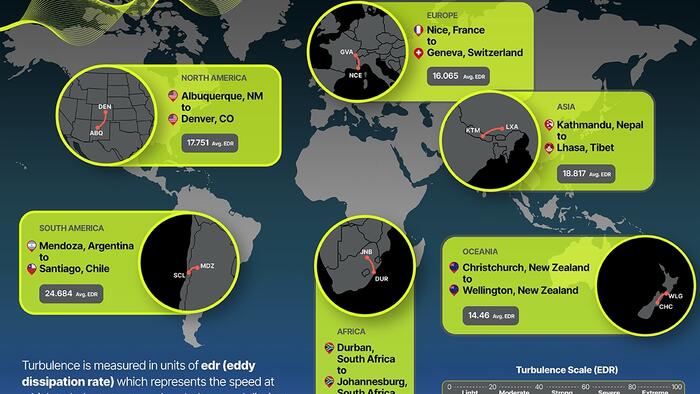


The visual below, created by Julie Peasley via Visual Capitalist, maps the single most turbulent flight route on each continent using Turbli’s 2024 rankings.
Turbli compiles daily turbulence along actual flight tracks and reports average intensity using the eddy dissipation rate (EDR) scale from 0 to 100 (light to extreme).
South America’s Mendoza (MDZ)–Santiago (SCL) tops the chart at 24.684 average EDR, followed by mountain-hugging routes such as Kathmandu–Lhasa, Albuquerque–Denver, and Christchurch–Wellington.
Interestingly, SCL has the distinction of being the world’s most turbulent airport. Europe’s Nice–Geneva and Africa’s Durban–Johannesburg also make the list.
Several of the bumpiest routes trace over or alongside major mountain chains—the Andes, Himalayas, Alps, and Southern Alps—where strong winds can generate mountain waves, rotors, and turbulent shear. Island-to-island or strait crossings (e.g., Wellington) also see rough air as winds accelerate through gaps.
A growing body of research points to more frequent clear-air turbulence (CAT), driven by climate change. Warmer air intensifies wind shear in jet streams; over the North Atlantic, the annual duration of severe CAT increased about 55% between 1979 and 2020, with notable rises across other busy regions as well.
EDR is an objective, aircraft-independent measure of turbulence intensity and the ICAO/WMO standard used in aviation. NCAR and partners compute EDR from onboard parameters to create consistent, comparable reports, which is exactly the kind of metric Turbli aggregates for its rankings.
Rougher skies don’t mean flying is unsafe. Modern aircraft are designed for turbulence, and injuries are rare when seat belts are fastened. For broader context on risk, see our chart on air travel fatalities per million passengers.
Explore more aviation data, including Longest Flights of the World, on Voronoi.

